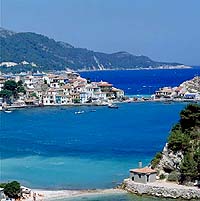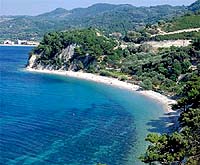Samos is an island of the eastern Aegean Sea. It is only 1500 meters far from the coasts of Minor Asia, where Greek culture of ancient Ionia bloomed. The seven-stage straight of ancient Greeks is the one that unites Samos whith Minor Asia. Its favourable position at the sea crossroad that link central Greece with East played a significant role for its development. Several megatheriums and other rare speciies of the prehistorical era lived on this island. Bones that were found the previous century decorate the show -cases of the palaelontological museums of US and Europe. Some of these palaentological findings are the museum of Mytilinion of Samos.
 Traces of the human race have been found at the Hill of Castro from the late neolithic era (4th millenium b.C.). The first inhabitantw belong to the Pelasgic tribes that spread the worship of Hera. According t mythology, Hera was born at the banks of the rive Imvrasss and was considered as the prtectress of Samos. Thus, her sacre dird, the peacok, often appeared on currency and escutchen of the hegemony of Samos later.
Traces of the human race have been found at the Hill of Castro from the late neolithic era (4th millenium b.C.). The first inhabitantw belong to the Pelasgic tribes that spread the worship of Hera. According t mythology, Hera was born at the banks of the rive Imvrasss and was considered as the prtectress of Samos. Thus, her sacre dird, the peacok, often appeared on currency and escutchen of the hegemony of Samos later.
It is possible that the name of Samos was given by the phoenicians and means “a place somewhere high”. The island has several other names, like Parthenia, Imvrasia, Anthemis, Dryousa, Doryssa, Phyllas and others.
After the Pelasgics, the Kares and Leleges inhabited the island. The first mytholgical king of Sams was Ageos, a hero of the Argonautic Expedition, who bullt the first wooden temple and placed in it the gooden status of godess Hera. In the middle of the 5th century b.C., Samos had developped trade, navigation, education and arts. By this time works, sush as the temple of Hera, the walls, the port and one must not forget the Ephpalinio tunel.
After the Persian wars, Samos acquired its freedom and became an equal member of the Athenian alliance. During the Pelopponesian war Samos fought on the side of Athens. In 129 b.C. Samos was conquered by the Romans , who stripped the island f all its treasures and took them Rome. Later , in 4o a.C. Samos was conquered by Byzantines and belonged to the Byzantine state till the disruption of the empire and the crusaders in 1204 a.C. . The island was hard hit by several attacks and sacks by pirates, Arabs, Venetians, Turks and other invaders, Nevertheiess, it managed to maintain its Christian and Greek features.In 1475, being pressed by Turk invaders inhabitans immigrated to Chios and the oppoosite coasts. Its population was reduced s much, that many refer to this perid till 1565 as the “desertation” of Samos . In the middle of the 16th century, Sams was settled by Greek populations t which special priviledges were given by the sultan., and which priviledges established soome kind of self-gvernment under the rule of the Sultan. Slowly the poplation increased and todays villages were formed.
 In 1821 the island revited having as leader Logothetis Lykourgos and acquired its freedom , but in 1830 when the independence of the Greek state was recognized, Samos was not included within the limits of Greece .Samians continued fighting for their union with Greece until 1834 but they didn'’t succeed.
In 1821 the island revited having as leader Logothetis Lykourgos and acquired its freedom , but in 1830 when the independence of the Greek state was recognized, Samos was not included within the limits of Greece .Samians continued fighting for their union with Greece until 1834 but they didn'’t succeed.
The European Powers, England, France and Russia decided to deciare Samos as an autonomous hegemony under the suzerainty of the High Gate. The Sultan conceded priviledges and in 1834 the regime of Hegemony was inflicted. The administration of the island was exercised by the Governor, a Greek Christian officical of the Gate, appointed by the Sultan, The Parliament consisting of 4 members, elected by the proxies of the villages of Samos, who formed every year the General Meeting of the proxies. Samos remained under this regime till 1912, when after a revolutin by Themistoklis Sofouli, its union with Greece was declared. In the 2nd World War , in 1941, the island was conquered by Italian trops, while duringthe occupancy, a resistent movement developed on its mountains, against the “powers of the axe”. It was the first Greek iand to acquire its freedom, but only temporarily, from September 1943 till November 1943, when it experienced the German occupation. After the civil war, Samos begun developping again , and today, despite the destructions due to fires every years, it remains one of the most green and beautiful islands of eastern Aegean.
One can find several monuments of ancient civillisation at its archaelogical museums and thrughout the plains of Chora , from the Pythagorio to the Heraenon, One can visit the Byzantine-Ecclesiastical Museum , The Public Library , the two historical Archives, a Paleontological and Folkioric Museums. Exscavations are being carried out at its archaelogical sites, while the Ephpalinion tunel has almost been cleaned and electrically lit, so as to be accessible to visitors.
The modern culture of Samos is impressed on the traditional built-up areas, the extraordinary churches, most of which were bulit during the 18th and 19th century, the 16th century monasteries, the imprressive neoclassical buildings, the tanneries at Karlovasi, tobacco factories and wine- stores that also indicate the main activities of its inhabitants; one must add to these, the several hotel groups, which imply the modern vocational activities of the island.
 Traces of the human race have been found at the Hill of Castro from the late neolithic era (4th millenium b.C.). The first inhabitantw belong to the Pelasgic tribes that spread the worship of Hera. According t mythology, Hera was born at the banks of the rive Imvrasss and was considered as the prtectress of Samos. Thus, her sacre dird, the peacok, often appeared on currency and escutchen of the hegemony of Samos later.
Traces of the human race have been found at the Hill of Castro from the late neolithic era (4th millenium b.C.). The first inhabitantw belong to the Pelasgic tribes that spread the worship of Hera. According t mythology, Hera was born at the banks of the rive Imvrasss and was considered as the prtectress of Samos. Thus, her sacre dird, the peacok, often appeared on currency and escutchen of the hegemony of Samos later.It is possible that the name of Samos was given by the phoenicians and means “a place somewhere high”. The island has several other names, like Parthenia, Imvrasia, Anthemis, Dryousa, Doryssa, Phyllas and others.
After the Pelasgics, the Kares and Leleges inhabited the island. The first mytholgical king of Sams was Ageos, a hero of the Argonautic Expedition, who bullt the first wooden temple and placed in it the gooden status of godess Hera. In the middle of the 5th century b.C., Samos had developped trade, navigation, education and arts. By this time works, sush as the temple of Hera, the walls, the port and one must not forget the Ephpalinio tunel.
After the Persian wars, Samos acquired its freedom and became an equal member of the Athenian alliance. During the Pelopponesian war Samos fought on the side of Athens. In 129 b.C. Samos was conquered by the Romans , who stripped the island f all its treasures and took them Rome. Later , in 4o a.C. Samos was conquered by Byzantines and belonged to the Byzantine state till the disruption of the empire and the crusaders in 1204 a.C. . The island was hard hit by several attacks and sacks by pirates, Arabs, Venetians, Turks and other invaders, Nevertheiess, it managed to maintain its Christian and Greek features.In 1475, being pressed by Turk invaders inhabitans immigrated to Chios and the oppoosite coasts. Its population was reduced s much, that many refer to this perid till 1565 as the “desertation” of Samos . In the middle of the 16th century, Sams was settled by Greek populations t which special priviledges were given by the sultan., and which priviledges established soome kind of self-gvernment under the rule of the Sultan. Slowly the poplation increased and todays villages were formed.
 In 1821 the island revited having as leader Logothetis Lykourgos and acquired its freedom , but in 1830 when the independence of the Greek state was recognized, Samos was not included within the limits of Greece .Samians continued fighting for their union with Greece until 1834 but they didn'’t succeed.
In 1821 the island revited having as leader Logothetis Lykourgos and acquired its freedom , but in 1830 when the independence of the Greek state was recognized, Samos was not included within the limits of Greece .Samians continued fighting for their union with Greece until 1834 but they didn'’t succeed.The European Powers, England, France and Russia decided to deciare Samos as an autonomous hegemony under the suzerainty of the High Gate. The Sultan conceded priviledges and in 1834 the regime of Hegemony was inflicted. The administration of the island was exercised by the Governor, a Greek Christian officical of the Gate, appointed by the Sultan, The Parliament consisting of 4 members, elected by the proxies of the villages of Samos, who formed every year the General Meeting of the proxies. Samos remained under this regime till 1912, when after a revolutin by Themistoklis Sofouli, its union with Greece was declared. In the 2nd World War , in 1941, the island was conquered by Italian trops, while duringthe occupancy, a resistent movement developed on its mountains, against the “powers of the axe”. It was the first Greek iand to acquire its freedom, but only temporarily, from September 1943 till November 1943, when it experienced the German occupation. After the civil war, Samos begun developping again , and today, despite the destructions due to fires every years, it remains one of the most green and beautiful islands of eastern Aegean.
One can find several monuments of ancient civillisation at its archaelogical museums and thrughout the plains of Chora , from the Pythagorio to the Heraenon, One can visit the Byzantine-Ecclesiastical Museum , The Public Library , the two historical Archives, a Paleontological and Folkioric Museums. Exscavations are being carried out at its archaelogical sites, while the Ephpalinion tunel has almost been cleaned and electrically lit, so as to be accessible to visitors.
The modern culture of Samos is impressed on the traditional built-up areas, the extraordinary churches, most of which were bulit during the 18th and 19th century, the 16th century monasteries, the imprressive neoclassical buildings, the tanneries at Karlovasi, tobacco factories and wine- stores that also indicate the main activities of its inhabitants; one must add to these, the several hotel groups, which imply the modern vocational activities of the island.

